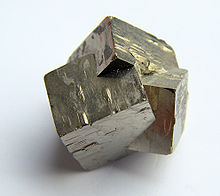- Crystal twinning
-
 Diagram of twinned crystals of Albite. On the more perfect cleavage, which is parallel to the basal plane (P), is a system of fine striations, parallel to the second cleavage (M).
Diagram of twinned crystals of Albite. On the more perfect cleavage, which is parallel to the basal plane (P), is a system of fine striations, parallel to the second cleavage (M).
Crystal twinning occurs when two separate crystals share some of the same crystal lattice points in a symmetrical manner. The result is an intergrowth of two separate crystals in a variety of specific configurations. A twin boundary or composition surface separates the two crystals. Crystallographers classify twinned crystals by a number of twin laws. These twin laws are specific to the crystal system. The type of twinning can be a diagnostic tool in mineral identification.
Twinning can often be a problem in X-ray crystallography, as a twinned crystal does not produce a simple diffraction pattern.
Contents
Types of twinning
Simple twinned crystals may be contact twins or penetration twins. Contact twins share a single composition surface often appearing as mirror images across the boundary. Plagioclase, quartz, gypsum, and spinel often exhibit contact twinning. Merohedral twinning occurs when the lattices of the contact twins superimpose in three dimensions, such as by relative rotation of one twin from the other. An example is metazeunerite. In penetration twins the individual crystals have the appearance of passing through each other in a symmetrical manner. Orthoclase, staurolite, pyrite, and fluorite often show penetration twinning.
 Galvanized surface with macroscopic crystalline features. Twin boundaries are visible as striations within each crystallite, most prominently in the bottom-left and top-right.
Galvanized surface with macroscopic crystalline features. Twin boundaries are visible as striations within each crystallite, most prominently in the bottom-left and top-right.
If several twin crystal parts are aligned by the same twin law they are referred to as multiple or repeated twins. If these multiple twins are aligned in parallel they are called polysynthetic twins. When the multiple twins are not parallel they are cyclic twins. Albite, calcite, and pyrite often show polysynthetic twinning. Closely spaced polysynthetic twinning is often observed as striations or fine parallel lines on the crystal face. Rutile, aragonite, cerussite, and chrysoberyl often exhibit cyclic twinning, typically in a radiating pattern.
Modes of formation
There are three modes of formation of twinned crystals. Growth twins are the result of an interruption or change in the lattice during formation or growth due to a possible deformation from a larger substituting ion. Annealing or transformation twins are the result of a change in crystal system during cooling as one form becomes unstable and the crystal structure must re-organize or transform into another more stable form. Deformation or gliding twins are the result of stress on the crystal after the crystal has formed. Deformation twinning is a common result of regional metamorphism.
Crystals that grow adjacent to each other may be aligned to resemble twinning. This parallel growth simply reduces system energy and is not twinning.
Twin boundaries
 Fivefold twinning in a gold nanoparticle (electron microscope image).
Fivefold twinning in a gold nanoparticle (electron microscope image).
Twin boundaries occur when two crystals of the same type intergrow, so that only a slight misorientation exists between them. It is a highly symmetrical interface, often with one crystal the mirror image of the other; also, atoms are shared by the two crystals at regular intervals. This is also a much lower-energy interface than the grain boundaries that form when crystals of arbitrary orientation grow together.
Twin boundaries are partly responsible for shock hardening and for many of the changes that occur in cold work of metals with limited slip systems or at very low temperatures. They also occur due to martensitic transformations: the motion of twin boundaries is responsible for the pseudoelastic and shape-memory behavior of nitinol, and their presence is partly responsible for the hardness due to quenching of steel.
Deformation twins
Of the three common crystalline structures BCC, FCC, and HCP, the HCP structure is the most likely to form deformation twins when strained, mainly due to the lack of slip systems in this structure.[citation needed]
See also
- Macle
References
- Hurlbut, Cornelius S.; Klein, Cornelis, 1985, Manual of Mineralogy, 20th ed., ISBN 0-471-80580-7
 This article incorporates text from a publication now in the public domain: Chisholm, Hugh, ed (1911). Encyclopædia Britannica (11th ed.). Cambridge University Press.
This article incorporates text from a publication now in the public domain: Chisholm, Hugh, ed (1911). Encyclopædia Britannica (11th ed.). Cambridge University Press.
External links
Categories:
Wikimedia Foundation. 2010.

